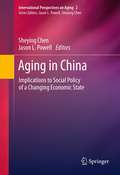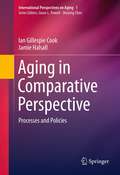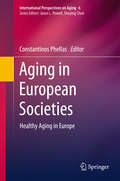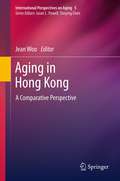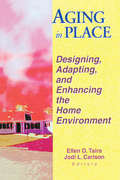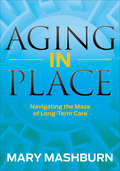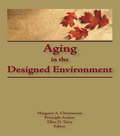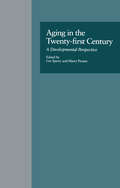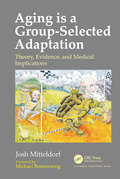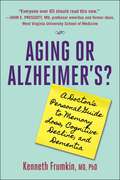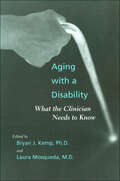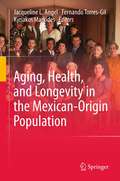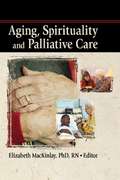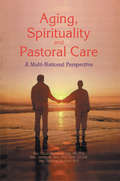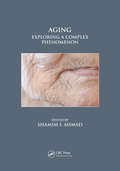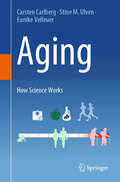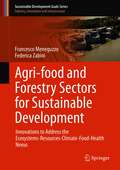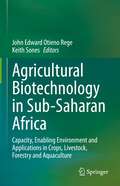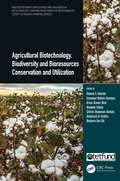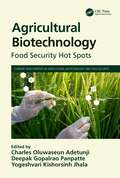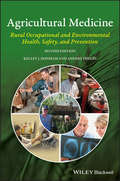- Table View
- List View
Aging in Asia: Findings from New and Emerging Data Initiatives
by James P. SmithThe population of Asia is growing both larger and older. Demographically the most important continent on the world, Asia's population, currently estimated to be 4.2 billion, is expected to increase to about 5.9 billion by 2050. Rapid declines in fertility, together with rising life expectancy, are altering the age structure of the population so that in 2050, for the first time in history, there will be roughly as many people in Asia over the age of 65 as under the age of 15. It is against this backdrop that the Division of Behavioral and Social Research at the U.S. National Institute on Aging (NIA) asked the National Research Council (NRC), through the Committee on Population, to undertake a project on advancing behavioral and social research on aging in Asia. Aging in Asia: Findings from New and Emerging Data Initiatives is a peer-reviewed collection of papers from China, India, Indonesia, Japan, and Thailand that were presented at two conferences organized in conjunction with the Chinese Academy of Sciences, Indian National Science Academy, Indonesian Academy of Sciences, and Science Council of Japan; the first conference was hosted by the Chinese Academy of Social Sciences in Beijing, and the second conference was hosted by the Indian National Science Academy in New Delhi. The papers in the volume highlight the contributions from new and emerging data initiatives in the region and cover subject areas such as economic growth, labor markets, and consumption; family roles and responsibilities; and labor markets and consumption.
Aging in China: Implications to Social Policy of a Changing Economic State (International Perspectives on Aging #2)
by Jason L. Powell Sheying ChenChina, which is fast on its way to becoming the most powerful economic force in the world, has four unique characteristics that distinguish it from other countries in Asia: (1) The proportion of aging population is growing faster than that of Japan (the country previously recognized as having the fastest rate) and much faster than nations in western Europe. (2) An early arrival of an aging population before modernization has fully taken place, with social policy implications. It is certain that China will face a severely aged population before it has sufficient time and resources to establish an adequate social security and service system for older people. (3) There will be fluctuations in the total dependency ratio. The Chinese government estimates are that the country will reach a higher dependent burden earlier in the twenty-first century than was previously forecast. (4) The government's fertility policy (single child per family) and its implementation has a strong influence on the aging process. Fewer children are being born, but with more elderly people a conflict arises between the objectives to limit population increase and yet maintain a balanced age structure (Peng and Guo 2001). The intersection of these fourfold factors means that the increased aging population is giving rise to serious concerns among Chinese social policy makers. There is a chronic lack of good resource materials that attempt to make sense of social policy in its relationship to examining the problems and possibilities of human aging grounded in an analysis of economic of social policy in China and impact on rural and urban spaces. Such analysis of China will be covered by conceptual, theoretical, and empirical approaches. The book will also discuss substantive topics of housing, community care, family care, pensions, and mental health. The book brings together a truly world class array of researchers to provide discussions of critical implications of aging social policy and the economic impact in China.
Aging in Comparative Perspective: Processes and Policies (International Perspectives on Aging #1)
by Jamie Halsall Ian Gillespie CookThis book examines the key aging processes in seven countries (United States, United Kingdom, Sweden, Japan, China, Nepal, and South Africa) and the main policies that have been, and are being, developed to deal with this rapid change in the demographic profile. It addresses the problems that are identified as well as the positive aspects of aging within each of these contrasting societies. Thus it makes a significant contribution to the major debates about growing old across the globe.
Aging in European Societies: Healthy Aging in Europe (International Perspectives on Aging #6)
by Constantinos PhellasBetween longer life expectancies and declining birth rates, Europe's elder population is growing into a sizable minority with considerable impact on nations, health systems, and economies--in other words, global implications as well as local and regional ones. Those investing in the health of older adults need a double perspective: the social and clinical complexity of aging and the larger forces shaping these experiences. Aging in European Societies examines aging trends across the continent, analyzing individual and collective variables that affect the lives of older adults, and drawing salient comparisons with other parts of the world. An interdisciplinary panel of experts provides theory, research, and empirical findings (with examples from the UK, Cyprus, Sweden, and others) in key areas such as family and social supports, physical and cognitive changes, dependence and autonomy issues, and living arrangements. The book's wide-net approach offers insights into not only aging, but aging well. And of particular importance, it details approaches to defining and measuring the elusive but crucial concept, quality of life. Included in the coverage: The potential for technology to improve elders' quality of life.Dementia and quality of life issues.Changes in functional ability with aging and over time.Family networks and supports in older age.Factors influencing inequalities in quality of life.Late-life learning in the E.U. Gerontologists, sociologists, health and cross-cultural psychologists, and public health policymakers will welcome Aging in European Societies as a springboard toward continued discussion, new directions for research, and improvements in policy and practice.
Aging in Hong Kong: A Comparative Perspective (International Perspectives on Aging #5)
by Jean WooWith the longest life expectancy for men and the second longest for women, Hong Kong typifies our planet's aging population. The daily lives of its older adults closely match the advantages and disadvantages experienced by urban elders in other developed countries. For these reasons, Hong Kong's elderly serve as a salient guide to older people's social, psychological, and healthcare needs--concerns of increasing importance as the world grows older. Aging in Hong Kong examines this emblematic population as a case study specifically in comparison with their counterparts in the West, shedding light on diverse, interrelated currents in the aging experience. Referencing numerous international studies, the book contrasts different health service arrangements and social factors and relates them to a variety of health outcomes. Its wide-ranging coverage documents health and illness trends, reviews age-friendly policy initiatives, relates health literacy to patients' active role in their own care, and discusses elders as an underserved group in the division of limited health funding and resources. This multiple focus draws readers' attention to policies that need revisiting or retooling as chapters analyze major life areas including: Living environment.Retirement and post-retirement employment issues.Financial asset management.Health literacy regarding aging issues.Elder-positive service delivery models.Ageism in the prioritization of healthcare.End-of-life issues. By assembling such a wealth of data on its subject, Aging in Hong Kong puts ongoing challenges into clear focus for gerontologists, sociologists, health and cross-cultural psychologists, public health policymakers, and others involved in improving the quality of elders' lives.
Aging in Place: Designing, Adapting, and Enhancing the Home Environment
by Jodi Carlson Ellen D TairaProvide a comfortable living environment for the aging!Aging in Place: Designing, Adapting, and Enhancing the Home Environment gives you a complete examination of current trends in adaptive home designs for older adults. As a therapist, designer, architect, builder, home planner, social worker, community organizer, or gerontologist, Aging in Place will show you innovative home designs and studies for creating environments that offer optimal living for aging adults. Complete with diagrams, floor plans, and tables, Aging in Place helps you to improve the quality of life for the elderly by offering them state-of-the-art designs that encourage independence and dignity. This unique and exciting book covers topics such as universal design which strives to create everyday environments and products like door handles and light switches that are usable by all people to the greatest extent possible, regardless of age or ability. Aging in Place will also show you how to: use follow-up visits by occupational therapists to ensure successful use of home modifications create environments that are helpful for vision rehabilitation by using controlled lighting and color schemes evaluate the quality of life for elderly people living in personal dwellings, specialized housing, and nursing homes explore architectural barriers and the uses of helping devices for elderly people examine research critiques of adaptive toilet equipment investigate modifications that have been made in homes for the elderly in India analyze ways in which elderly people have changed their homes to make the telephone more accessibleAging in Place is a complete guide to understanding the needs and latest trends in optimizing the living space of elderly persons. The book gives you access to several studies on elderly people's environmental needs and preferences in regard to modifications in personal and public dwellings. This information will assist you with better serving the elderly by helping them live more independently.
Aging in Place: Navigating the Maze of Long-Term Care
by Mary MashburnAn elder care expert offers essential information and advice on how to give your aging parent or loved one the best care possible in this stage of life. Caring for an aging parent or loved one can be overwhelming. From making sure their estate is in order and knowing their wishes are being honored, to more immediate concerns like where they will receive the best care after a hospital stay—there are many questions that are difficult to answer. In Aging in Place, certified senior advisor Mary Mashburn guides you through these and other common concerns so that you can address them with confidence and compassion. Using real life examples, Aging in Place promotes healthy family discourse on important elder care topics. Mary discusses the roadblocks and pitfalls you and your family might encounter, explains many useful planning techniques, and provides information on local and national resources. Whether in the midst of a crisis or just beginning to discuss options with loved ones, Aging in Place offers valuable insight and information on making choices that fit your unique situation.
Aging in the Designed Environment
by Ellen D Taira Margaret ChristensonAging in the Designed Environment is the key sourcebook for physical and occupational therapists developing and implementing environmental designs for the aging. The physical environment remains one of the most overlooked areas in environmental design. In order to move beyond this status quo, persons responsible for planning elderly environments must develop a new understanding of ways in which their influence can improve the older adult’s physical and mental functioning. Occupational and physical therapists, as well as other health care professionals, will benefit tremendously from the information presented in this unique volume. Designers, developers, and others with minimal health care background will also find a wealth of possibilities within Aging in the Designed Environment. Many concerns are dealt with in the book’s five sections. The first section describes the implications that occur when there are changes in vision, hearing, taste, smell, touch, and the kinesthetic systems. Recommendations for environmental adaptation and modifications which may compensate for the changes in each of these systems are suggested. The second section stresses the relationship between behavior and environment. A variety of environmental attributes--comfort, privacy, accessibility, control, security, dignity--and their impacts are discussed, along with information on ways that attributes can be incorporated into the living settings of older people. In section three the focus is on the older person living independently in his or her own home, and section four covers exclusively the design and selection of chairs for older adults. New ways to assess and evaluate the home to promote independence beyond the traditional activities of daily living are addressed. The last section deals with redesigning the existing long-term care facility. The author examines some of the environmental conditions existing in specific facilities and provides recommendations to compensate for these circumstances.
Aging in the Twenty-first Century: A Developmental Perspective (Issues in Aging)
by Len Sperry Harry ProsenCovering a wide range of topics, this collection of original essays deals with the consequences and challenges of our growing aging population on society. It emphasizes aging as a developmental process while addressing the future of the practice of geropsychiatry and geriatric psychotherapy. This book serves as a valuable resource to guide clinical training, practice, and research on aging into the next century and beyond.
Aging is a Group-Selected Adaptation: Theory, Evidence, and Medical Implications
by Joshua MitteldorfAlthough books exist on the evolution of aging, this is the first book written from the perspective of again as an adaptive program. It offers an insight into the implications of research on aging genetics, The author proposes the Demographic Theory of Senescence, whereby aging has been affirmatively selected because it levels the death rate over time helping stabilize population dynamics and prevent extinctions.
Aging or Alzheimer's?: A Doctor's Personal Guide to Memory Loss, Cognitive Decline, and Dementia
by Dr. Kenneth FrumkinIs it normal aging, Alzheimer&’s, or another dementia? Two of three Americans will experience cognitive impairment by the age of 70. But is it natural age-related forgetfulness, or the early indication of Alzheimer&’s Disease or other types of dementia? How worried should older people—or their families and friends—be about their memory loss? And what happens next? Kenneth Frumkin, PhD, MD, recently retired from a 36-year medical career and facing his own age- and memory-related challenges, provides an empathetic and comprehensive guide to answering those questions. Aging or Alzheimer's? explains what is currently known about the challenges to memory and cognition that come with longevity. Dr. Frumkin describes the progression of Alzheimer&’s Disease and other dementias; discusses when to see a doctor and what to expect from the visit; weighs the pros and cons of available tests, treatments, and research; shares personal and passionate tips for coping with decline; and gives the best ways to preserve cognitive health. There are an average of 15 new Alzheimer&’s publications per day. While busy practicing doctors often wait for the consensus reviews of new Alzheimer&’s studies that are published about every 10 years, Dr. Frumkin provides evidence-based, up-to-date guidance from the most current memory research. The result is your complete, modern guide to understanding and managing your—or your loved ones&’—memory loss or cognitive decline.
Aging with HIV in Sub-Saharan Africa: Health and Psychosocial Perspectives
by Catherine MacPhail Janet Seeley Mark Brennan-Ing Kristen E. Porter Jennifer E. KaufmanWith the development of effective antiretroviral therapies (ART) in the mid-1990s, HIV became a treatable although serious condition, and people who are adherent to HIV medications can attain normal or near-normal life expectancies. Because of the success of ART, people 50 and older now make up a majority of people with HIV in high-income countries and other places where ART is accessible. The aging of the HIV epidemic is a global trend that is also being observed in low- and middle-income countries, including countries in sub-Saharan Africa, where the greatest number of older people with HIV reside (3.7 million). While globally over half of older adults with HIV are in sub-Saharan Africa, we have little information about the circumstances, needs, and resiliencies of this population, which limits our ability to craft effective policy and programmatic responses to aging with HIV in this region. At present, our understanding of HIV and aging is dominated by information from the U.S. and Western Europe, where the epidemiology of HIV and the infrastructure to provide social care are markedly different than in sub-Saharan Africa. Aging with HIV in Sub-Saharan Africa addresses this gap in our knowledge by providing current research and perspectives on a range of health and psychosocial topics concerning these older adults from across this region. This volume provides a unique and timely overview of growing older with HIV in a sub-Saharan African context, covering such topics as epidemiology, health and functioning, and social support, as well as policy and program implications to support those growing older with HIV. There are very few published volumes that address HIV and aging, and this is the first book to consider HIV and aging in sub-Saharan Africa. Most publications in this area focus on HIV and aging in Uganda and South Africa. This volume broadens the scope with contributions from authors working in West Africa, Botswana, and Kenya. The range of topics covered here will be useful to professionals in a range of disciplines including psychology, epidemiology, gerontology, sociology, health care, public health, and social work.
Aging with a Disability: What the Clinician Needs to Know
by Ph. D. Laura Mosqueda Bryan J. KempWith advances in medical care, technology, and rehabilitation, people with disabilities are now living longer. Many, in fact, have near-average life expectancies. Research has shown, however, that the changes and problems associated with aging often occur 10–20 years earlier in the lives of people with disabilities than in the lives of people without disabilities. These changes pose significant challenges for health care professionals. Because research in this field is relatively recent, few practitioners and students are aware of these findings.Aging with a Disability provides clinicians with a complete guide to the care and treatment of persons aging with a disability. Divided into five parts, this book first addresses the perspective of the person with a disability and his or her family. Chapters in the second section address the physiological and functional changes people will face as they grow older, and how these changes may affect quality of life and caregiver requirements. In the third part, contributors discuss treatment considerations such as maintaining employment and managing pain and fatigue. The book's fourth section focuses on specific conditions: spinal cord injury, polio, cerebral palsy, and developmental disabilities such as mental retardation. In the concluding section, the authors present research needs and discuss policy issues for future consideration. Paying special attention to the feelings, attitudes, and needs of people with disabilities—three chapters are written by authors who have a disability—Aging with a Disability gives students and clinicians a reliable and compassionate handbook for the treatment of this growing population.
Aging, Health, and Longevity in the Mexican-Origin Population (Social Disparities In Health And Health Care Ser.)
by Jacqueline L. Angel Fernando Torres-Gil Kyriakos MarkidesAging, Health, and Longevity in the Mexican-Origin Population creates a foundation for an interdisciplinary discussion of the trajectory of disability and long-term care for older people of Mexican-origin from a bi-national perspective. Although the literature on Latino elders in the United States is growing, few of these studies or publications offer the breadth and depth contained in this book.
Aging, Spirituality and Palliative Care
by Rev Elizabeth MackinleyGain greater depth of understanding of end-of-life spiritual issues for older adultsThe period of time when a person approaches death is always difficult both for the patient and the caregiver. Aging, Spirituality, and Palliative Care discusses best practices in aged and palliative care while addressing patients&’ diverse spiritual
Aging, Spirituality, and Pastoral Care: A Multi-National Perspective
by James W EllorHow can you foster spiritual growth in older people?This multidisciplinary work re-examines issues of aging with dignity and spiritual meaning. Aging, Spirituality, and Pastoral Care: A Multi-National Perspective brings together chaplains, pastors, counselors, and health care practitioners in all walks of gerontology from around the world to present a fully rounded picture of the spiritual needs and potentialities of this fast-growing population. It also includes a study of the spiritual awareness of nurses working in six different nursing homes, as well as a model for a parish nursing practice that focuses on the aged. Aging, Spirituality, and Pastoral Care addresses urgent issues for older people, including: social and spiritual isolation the wisdom of the aging the need for intimacy sexuality among older people living with dementia the spiritual dimensions of caregiving
Aging: Exploring a Complex Phenomenon
by Shamim I. AhmadThis book is a detailed and comprehensive synthesis of the scientific study of aging. Dozens of contributions from leading scholars review various theories of aging, and molecular, cellular, biochemical and microbial aspects of aging, among just a few of the topics included. Authoritative, wide ranging and thorough, this book will act as a source for experimental design, a comprehensive description of age related diseases, and provide information of the latest molecular theories underlying their causes. Additionally, it will target industries involved in developing anti-aging drugs, post-graduate medical students, and university libraries.
Aging: How Science Works
by Carsten Carlberg Eunike Velleuer Stine M. UlvenAging is a topic that concerns all of us, since none of us can escape it. The molecular and cellular process is built in every of the billions of cells forming our body. Some of these cells, such as immune cells and red blood cells, live only for a few days to weeks and get life-long constantly replaced by cells produced in the bone marrow. In contrast, there are cells, such as neurons and memory lymphocytes, that get as old as we get. The process of aging limits our maximal life span, which is for our humans 120 years. However, only a very few individuals reached this age. How did their life differ from others that died decades earlier? Is it just the absence of life threatening disease paired with a more healthy life style? Or is it build in in our genome or epigenome? In this book we try to give answers to these questions from the perspectives of evolution, our genome, the epigenomes of our different tissues and cell types and the functionality of our cells. We should try to understand ourselves in detail as well as in a global setting. Basic biology explains cellular mechanisms, such as growth, differentiation, and cell death, which make life as a whole possible. Every (human) organism represents a complex interplay between hundreds of different cell types forming distinctive tissues and organs with specialized tasks. These processes need to be highly orchestrated especially during development, maintenance and aging. Studying the cellular and molecular basis of aging is one of the most fascinating areas but also a great challenge. Nevertheless, research made the biggest steps in elucidating biological processes via studying malfunctions of normal mechanisms leading to different diseases, such as progeroid syndrome and cancer. We will start this book with the understanding of the human genome in relation to principles of evolution. Then we will explain the basics of gene regulation and epigenetics, i.e., the interplay of transcription factors and chromatin. Next, we will shift to cellular mechanisms of aging and discuss then the impact of nutrition and immunity on the aging process. In the following the relation of aging to so-called aging-related common diseases, such as type 2 diabetes, atherosclerosis, cancer and Alzheimer. Do we get these diseases because we are aging or are we aging because we get one of these diseases? The book will end how we can slow down the aging process so that we can age healthy. In short, healthy aging is not an option but is a must. An ancient poem says “Teach us to number our days, that we may get a heart of wisdom.” It is up to each one of us and a daily decision to live a healthy lifestyle and to be aware of the unique gift of live we all have.
Agri-food and Forestry Sectors for Sustainable Development: Innovations to Address the Ecosystems-Resources-Climate-Food-Health Nexus (Sustainable Development Goals Series)
by Francesco Meneguzzo Federica ZabiniThis book surveys state-of-the-art and prospective practices, methods and technologies in agri-food and forestry sectors to document the potential measurable improvements in areas of environmental management, food security, economic growth, social cohesion and human health at the local and global scale. With a focus on the ecosystems-resources-climate-food-health nexus as a framework towards achieving the UN Sustainable Development Goals applicable in these sectors, the book offers a portfolio of guidelines and standards that assesses the affordability, potential profitability and possible unintended consequences of interventions. The areas of intervention covered in the study include global and local forest resources management, safe wastewater reuse for irrigation, sustainable crop and plant protection (e.g. biopesticides, bioherbicides), carbon sequestration and emission reduction strategies, and safe processing methods for food and food waste (e.g. sustainable food preservatives and healthier food). The book is primarily intended for academics, professionals, and policymakers. The professional audience, including enterprises in the forestry, farming, food processing, healthcare and waste management sectors, will take advantage of the updated knowledge basis concerning the innovations in the respective practices, methods and technologies, including their feasibility, affordability and profitability, and policymakers will find useful the comprehensive review of these innovations which could be strategically promoted and deployed in the next decade, with the aim of achieving the UN Sustainable Development Goals.
Agricultural Adaptation to Climate Change in Sub-Saharan Africa: Evidence from Senegal (Advances in African Economic, Social and Political Development)
by Marieme ToureIn the light of the impact of extreme weather events, declining agricultural productivity and child malnutrition in sub-Saharan Africa, this book explores the potential for sustainable agriculture to better respond to climate-related threats. By presenting a case study of Senegal, the author offers insights into the impact of climate change on long-term crop production, food security, and child malnutrition. Furthermore, the study sheds new light on the financialization of agricultural production and foreign direct investments, discusses policy instruments and adaptation strategies for implementing sustainable agriculture, and highlights the role of green financing instruments to enable the harmonization of private financing and green infrastructure. It will appeal to scholars of agricultural and development economics, and anyone interested in climate risk mitigation strategies and sustainable agriculture to achieve a green transition in sub-Saharan Africa.
Agricultural Biotechnology in Sub-Saharan Africa: Capacity, Enabling Environment and Applications in Crops, Livestock, Forestry and Aquaculture
by John Edward Otieno Rege Keith SonesThis book offers a comprehensive analysis of the application level for various agricultural biotechnologies across Sub-Saharan Africa. The authors examine the capacity available as well as the enabling environment, including policy and investments, for facilitating agricultural biotechnology development and use in the region. For each Sub-Saharan country, the status of biotechnology application is assessed in four major sectors; Crops, Livestock, Forestry and Aquaculture. Examples such as the number and requisite skill levels of trained personnel, biosafety frameworks and public awareness are surfaced in these chapters. This work also discusses the impact of push-pull factors on research, training and food security and identifies opportunities for investment in biotechnology and local agribusiness.Development partners, policy makers, agricultural consultants as well as scientists and private sector investors with an interest in biotechnology initiatives in Sub-Saharan Africa will find this collection an important account to identify key gaps in capacity and policy, as well as priority areas going forward. The volume highlights ways to develop technology and increase agricultural production capacity through international cooperation and inclusive economic growth, making it a valuable practice guide in line with the UN Sustainable Development Goals, in particular SDG 2 Zero Hunger and SDG 8 Decent Work and Economic Growth. Clear case studies round off the reading experience.
Agricultural Biotechnology, Biodiversity and Bioresources Conservation and Utilization (Multidisciplinary Applications and Advances in Biotechnology)
by Charles Oluwaseun Adetunji Abdulrazak B. Ibrahim Benjamin Ewa Ubi Olawole O. Obembe Abubakar Gidado Emmanuel Olufemi Ekundayo Arinze Stanley OkoliThis book covers a range of important topics on crop and animal genetics, breeding and genomics, as well as biodiversity and genetic resources conservation and utilization reflecting three thematic sections of working groups of the Biotechnology Society of Nigeria. The topics range from agricultural biotechnology, including genetically modified organisms and gene-editing for agronomically important traits in tropical crops, to Nigeria’s mega biodiversity and genetic resources conservation. This book will engender a deeper understanding of underpinning mechanisms, technologies, processes and science–policy nexus that has placed Nigeria as a leader in biotechnology in Africa. The book will be useful reference material for scientists and researchers working in the fields of food and agricultural biotechnology, bioinformatics, plant and animal genetics, breeding and genomics, genetic resources conservation and enhancement. Emphasizes recent advances in biotechnologies that could ameliorate the high-level global food and nutrition insecurity through plant and animal genetics, breeding, as well as genomics Provides detailed information towards harnessing indigenous bioresources for food and nutrition security and climate change adaptation Introduces new frontiers in the area of genomics, most especially their relevant applications in crop and animal breeding Reviews biotechniques that could enhance plant genetic resources conservation and utilization Discusses current biotechnological approaches to exploit genetic resources including the development of synthetic hexaploid wheat (SHW) for crop adaptation to the increasingly changing global climate
Agricultural Biotechnology: Food Security Hot Spots (Current Developments in Agricultural Biotechnology and Food Security)
by Charles Oluwaseun Adetunji Deepak Gopalrao Panpatte Yogeshvari Kishorsinh JhalaThis book presents strategies and techniques highlighting the sustainability and application of microbial and agricultural biotechnologies to ensure food production and security. This book includes different aspects of applications of Artificial Intelligence in agricultural systems, genetic engineering, human health and climate change, recombinant DNA technology, metabolic engineering and so forth. Post-harvest extension of food commodities, environmental detoxification, proteomics, metabolomics, genomics, bioinformatics and metagenomic analysis are discussed as well. Features: Reviews technological advances in microbial biotechnology for sustainable agriculture using Artificial Intelligence and molecular biology approach. Provides information on the fusion between microbial biotechnology and agriculture. Specifies the influence of climate changes on livestock, agriculture and environment. Discusses sustainable agriculture for food security and poverty alleviation. Explores current biotechnology advances in food and agriculture sectors for sustainable crop production. This book is aimed at researchers and graduate students in agriculture, food engineering, metabolic engineering and bioengineering.
Agricultural Medicine: Rural Occupational and Environmental Health, Safety, and Prevention
by Kelley J. Donham Anders ThelinNewly updated, Agricultural Medicine: Rural Occupational Health, Safety, and Prevention, Second Editionis a groundbreaking and comprehensive textbook and reference for students and practitioners of public health, and professionals in the field of rural agricultural occupational health and safety. The book introduces specific occupational and environmental health and safety issues faced by agricultural workers and rural residents, and provides a roadmap to establishing sustainable worker and public health support in agricultural communities. Responding to reader demand, Agricultural Medicine, Second Edition now features more case studies, key point summaries, and new international perspective chapters comparing North American health and agricultural practices to those in Europe, the Asia Pacific, and South America. Agricultural health and safety engages a multidisciplinary team of medical professionals, veterinarians, safety professionals, engineers, sociologists, epidemiologists, and psychologists, for whom this book serves as an essential resource.
Agro-Technology
by R. Paul ThompsonHumans have been modifying plants and animals for millennia. The dawn of molecular genetics, however, has kindled intense public scrutiny and controversy. Crops, and the food products which include them, have dominated molecular modification in agriculture. Organisations have made unsubstantiated claims and scare mongering is common. In this textbook Paul Thompson presents a clear account of the significant issues - identifying harms and benefits, analysing and managing risk - which lie beneath the cacophony of public controversy. His comprehensive analysis looks especially at genetically modified organisms, and includes an explanation of the scientific background, an analysis of ideological objections, a discussion of legal and ethical concerns, a suggested alternative - organic agriculture - and an examination of the controversy's impact on sub-Saharan African countries. His book will be of interest to students and other readers in philosophy, biology, biotechnology and public policy.

